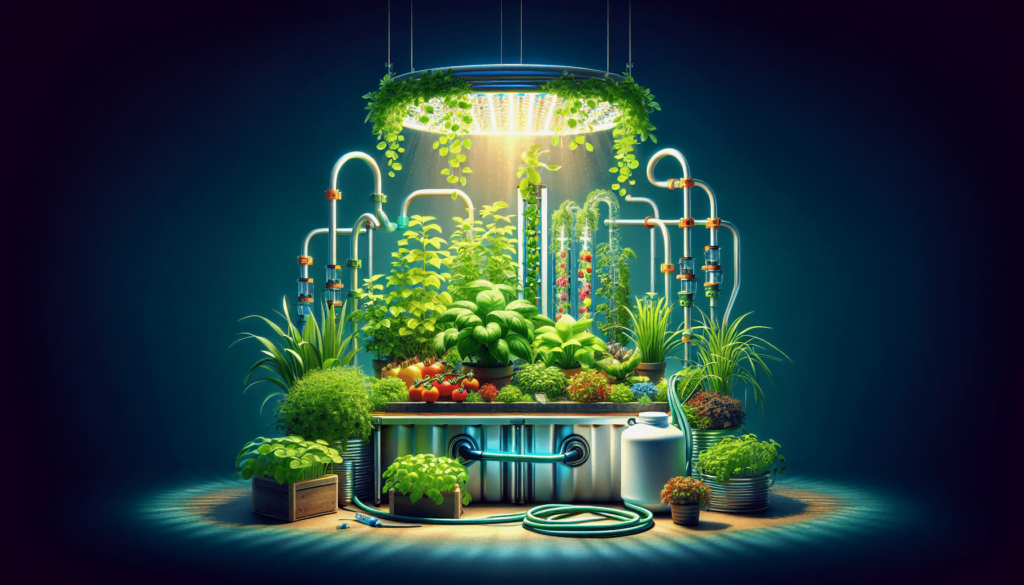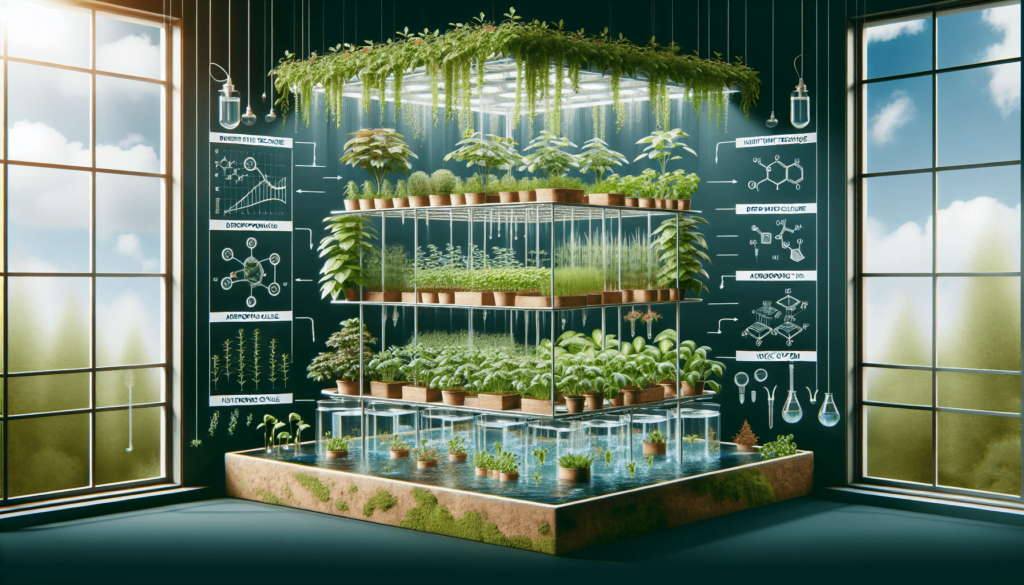Eager to start a home garden but lack the outdoor space? Fear not, as hydroponics can be your best bet. In this comprehensive guide named “The Ultimate Guide to the Most Popular Hydroponic Plants to Grow at Home”, we’ll share with you the most popular plants you can cultivate right in the comfort of your home, using the hydroponics technique. You’d be amazed by the lush, green bounty you can harvest from a tiny corner of your living space. Just imagine plucking fresh basil for pasta, or picking plump tomatoes for a juicy salad, all year round. Come along with us on this incredible journey of home gardening without ever having to touch soil.

Understanding Hydroponics
When we talk about hydroponics, many of us envision futuristic methods of growing plants without soil. In actuality, it’s a method of cultivation that can be as straightforward or as complex as we choose to make it.
Definition of Hydroponics
Hydroponics is a method of growing plants without soil, instead using mineral nutrient solutions in water. Plant roots are immersed in this solution, or misted with it, providing them with water and the necessary nutrients to flourish.
History of Hydroponics
Hydroponics is not some futuristic concept. Instead, it’s a very ancient method of cultivation. From the Hanging Gardens of Babylon to the Floating Gardens of the Aztecs, people have recognized the benefits of hydroponic gardening centuries ago. Even so, it wasn’t until the 19th century that scientists began to understand the dynamics of plant nutrition, leading to the modern system of hydroponics we know today.
Types of Hydroponic Systems
There are six types of hydroponic systems that we can pick from for our garden: the Wick system, the Water Culture system, the NFT system or Nutrient Film Technique, the Ebb and Flow system, the Drip system, and the Aeroponic system. All of these have their own unique strengths and weaknesses, and the optimal system can differ depending on our specific circumstances and goals.
Benefits of Hydroponic Gardening
Hydroponic gardening offers several advantages over soil cultivation. It enables us to grow plants anywhere, even indoors or in barren land, and allows for year-round cultivation. It requires less space, grows plants faster, and uses less water than traditional gardening. Moreover, it eliminates soil-borne diseases and pests, reduces the need for pesticides, and makes nutrient management easier.
Getting Started with Hydroponic Gardening
With a basic understanding of what hydroponics entails, let’s dive into how we could set up our own hydroponic garden at home.
Choosing the Right Hydroponic System
The first step in starting a hydroponic garden is to choose the suitable system based on our requirements, space, budget, and the plants we intend to grow. For beginners, we often recommend the Wick system or the Water Culture system due to their simplicity and low start-up costs.
Setting up Your Hydroponic Garden
Setting up a hydroponic garden requires careful planning and organization. This includes choosing the suitable location, setting up the system, preparing the nutrient solution, and planting the crops.
Understanding the Role of Nutrients
In hydroponics, plants receive their nutrients directly from the water. These nutrients must be well-balanced and cover a wide range of macro and micronutrients to ensure healthy and robust plants. Major nutrients required by plants include nitrogen, phosphorus, and potassium, along with calcium, magnesium, and a range of trace elements.
Temperature and Light Requirements
In hydroponics, controlling the growing environment is crucial. Optimal light, temperature, and humidity levels need to be maintained. Most plants prefer a temperature range of 18-30°C and require light for photosynthesis. Getting these conditions right can significantly affect the growth and productivity of our plants.
Monitoring pH and Nutrient Levels
Regular monitoring of pH and nutrient levels in the solution is essential. An ideal pH range for most plants is 5.5 to 6.5. Also, places check for deficiencies or excess nutrients as they can both negatively affect plant health.
Most Popular Hydroponic Plants
When choosing plants for hydroponic cultivation, there are a few things to keep in mind.
Selection Criteria for Hydroponic Plants
The best plants for hydroponics are those that thrive in water, have a relatively small root system, and grow well under controlled conditions. Leafy greens, herbs, and some fruits and vegetables are excellent choices.
Understanding the Unique Needs of Each Plant Species
Each plant species has its own unique needs that need to be met to ensure successful growth. From nutrient requirements to light and temperature preferences, these needs need to be understood and catered to when setting up a hydroponic garden.
Hydroponic Lettuce
One of the most popular plants grown hydroponically is lettuce.
Benefits of Growing Lettuce Hydroponically
Hydroponic lettuce grows faster than soil-grown lettuce and can be harvested multiple times. It also requires less space per unit of production and can be grown year-round in managed environments.
Lettuce Varieties to Consider
When selecting a lettuce variety, consider its specific needs and adaptability to hydroponic systems. For example, leaf lettuces like Romaine and Butterhead are excellent choices for hydroponics.
The Growth Cycle of Hydroponic Lettuce
From seeding to harvest, the growth cycle of hydroponic lettuce spans about 45-60 days. Close monitor nutrient mixtures and light levels for optimum growth.
Tips & Tricks for Growing Lettuce
For growing lettuce, maintain a pH range of 6 to 7 and temperatures between 55° and 75°F. Also, keep the nutrient levels well balanced for vigorous growth.

Hydroponic Tomatoes
Tomatoes are another excellent plant for hydroponic growers.
Reasons to Grow Hydroponic Tomatoes
Hydroponic tomatoes yield more, taste better, and are less likely to be victim to soilborne diseases and pests. They can also be grown year-round, providing us with fresh tomatoes regardless of the season.
Selecting the Perfect Tomato Variety
Choosing the right tomato variety depends on individual preferences, system suitability, and market demand. Hybrid varieties like Better Boy, Big Beef, and Celebrity are generally good choices for hydroponics.
The Tomato’s Growth Cycle in Hydroponics
From seed to harvest, tomatoes have a growth cycle of 60-80 days under hydroponic conditions. It requires close monitoring of temperatures, light, and nutrient levels.
Proven Advice for Tomato Growing Success
For successful tomato cultivation, maintain a pH range of 5.5 to 6.5 and temperatures between 65° and 75°F. Pruning and training the plants can enhance fruit production.
Hydroponic Herbs
Cultivating herbs hydroponically can be a rewarding experience.
Growing Herbs in a Hydroponic System
Growing herbs hydroponically not only produces a higher yield but also enhances the flavor and aroma of the herbs. It also allows for continuous harvests, so we can enjoy fresh herbs year-round.
Best Herb Varieties for Hydroponics
Basil, parsley, dill, chives, cilantro, and mint are only a few of the many herbs that thrive in a hydroponic environment.
Understanding the Growth Cycle of Herbs
Herb growth cycles can vary, yet most grow quickly in hydroponic systems, allowing us to replenish our kitchen regularly.
Keeping Your Herbs Healthy and Productive
Regular pruning and harvesting promote bushier and more productive growth in most herb species. Also, ensure your herbs are getting the correct lighting, temperature, and nutrient balance.
Hydroponic Strawberries
Growing strawberries hydroponically can be both fun and rewarding.
The Advantages of Hydroponic Strawberries
By growing strawberries hydroponically, we can have fresh strawberries year-round—no more waiting for them to be in season. They also tend to be larger and more flavorful than their soil-grown counterparts.
Choosing the Right Strawberry Variety
When choosing a strawberry variety for hydroponics, we should consider factors like fruit size, yield, disease resistance, and taste. Day-neutral varieties are often chosen because they can fruit year-round when given the right conditions.
Understanding the Hydroponic Growth Cycle of Strawberries
From planting to harvest, the hydroponic growth cycle of strawberries is about four to six months. However, with the right care and conditions, we can get multiple harvests per year.
Key Tips for Successful Strawberry Growth
For successful growth, strawberries require a pH range of 5.5 to 6.5 and temperatures between 60° and 75°F. Also, carefully manage the nutrient mix to prevent diseases and promote healthy growth
Hydroponic Peppers
Peppers are a widely grown hydroponic crop due to their adaptability and consumer demand.
Why Grow Peppers Hydroponically
Peppers grown hydroponically can produce higher yields, have more robust flavors, and are often of better quality. Also, they can be grown year-round in controlled conditions.
Selecting the Best Pepper Variety
When choosing a pepper variety, we should consider market preference, disease resistance, heat level, and compatibility with hydroponic systems.
Learning About the Hydroponic Pepper Growth Cycle
From planting to harvest, peppers can have a growth cycle of 70-90 days. It is important to monitor temperatures, light levels, and nutrient mixtures for optimum growth.
Methods to Maximize Pepper Production
For successful cultivation, peppers require a pH range of 6 to 6.5 and temperatures between 70° and 85°F. Also, consider pruning and nurturing flowers for better fruit production.
Hydroponic Cucumbers
Cucumbers are one of the most common vegetables grown in hydroponic systems.
Benefits of Hydroponic Cucumbers
Hydroponic cucumbers grow faster, yield more, and have a crispier texture and better flavor than soil-grown varieties. Also, they can be grown throughout the year.
Choosing the Perfect Cucumber Variety
Choosing the suitable cucumber variety depends on individual preferences, suitability to the system, and market demand. Check disease resistance and yield potential before choosing.
Cucumber’s Hydroponic Growth Cycle
From seeding to harvest, hydroponic cucumbers have a growth cycle of about 50-70 days. It requires much attention to temperature, light, and nutrient levels.
Best Practices for Growing Cucumbers
For successful cultivation, cucumbers require a pH range of 5.5 to 6.0 and temperatures between 75° and 85°F. Regular pruning and training can enhance productivity.
Troubleshooting Hydroponic Gardens
While establishing a hydroponic garden can be a smooth process, like all things gardening, it does have its share of challenges.
Common Hydroponic Plant Problems
From nutrient deficiencies and excess to pH imbalance, pests, and diseases, there can be a number of issues that may arise in a hydroponic system. Understanding these problems and their signs can help us take quick remedial measures.
Organic Pest Control for Hydroponics
Organic pest control methods are preferred in hydroponics. These could include insecticidal soap, neem oil, or introducing beneficial insects into the garden.
Remedying Nutrient Deficiencies
Identifying and remedying nutrient deficiencies is essential to maintain plant health. Often, adjusting the nutrient mixture can fix the problem.
Tips for Maintaining a Healthy Hydroponic Garden
For a healthy hydroponic garden, regular monitoring and maintenance are crucial. Always check the pH and nutrient levels, cleanliness of the system, proper functioning of pumps and timers, and daily observe the condition of the plants for any signs of stress or disease.
With the right knowledge and some commitment, we can grow any plant hydroponically, reaping the benefits of this exciting method of cultivation!
Forum
Got something to share or a question to ask? Jump in and start a conversation! Whether it’s tips, advice, or just sharing your experiences, we’d love to hear from you. Don’t be shy—your input could inspire or help someone else!- This forum has 1 topic, and was last updated 10 months, 2 weeks ago by .
- Topic
- Voices
- Last Post
- You must be logged in to create new topics.


